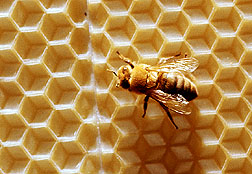Helping Honey Bees Fight Mites
If honey bees would build smaller cells—the six-sided cubbyholes that are a hive's basic architectural units—these beneficial insects might better withstand devastating parasitic mites.
"Commercial beekeepers nationwide have lost about half their hives over the past several years to infestations of tracheal mites that originated in Europe and varroa mites from Asia," says Agricultural Research Service entomologist Eric H. Erickson. "The 1990s have been even harder for feral, or wild honey bees. A combination of mite attacks and the harsh 1996 winter killed up to 90 percent of feral honey bees in some parts of the country."
"Cold weather kills honey bees, and bees already stressed by parasites are especially vulnerable," says Erickson, research leader at ARS' Carl Hayden Bee Research Laboratory in Tucson, Arizona.
Tracheal mites lodge in the breathing tubes of adult bees, suffocating them, while varroa mites suck blood from both the adults and pupae. Tracheal mites were first spotted in this country in 1984, varroa mites in 1987.
"During the winter of 1995-96, we had both colder than normal winter temperatures and widespread mite infections," Erickson says. "My own backyard was affected. I used to see bees on my citrus trees, but I didn't see any buzzing around last summer."
|
For information on inexpensive bee traps developed by ARS, click here. |
Erickson's research team has found improved honey bee survival through several research strategies. The latest is to get the bees to build smaller than usual cells to rear their young and store honey in.
The scientists did this by installing in the hive sheets of starter cells that are smaller than those typically used by beekeepers. Commercially managed honey bees use these starter cells as a blueprint for building their honeycomb. With wax they manufacture themselves, they form thousands of cells to create the many floors of the honeycomb. The smaller the starter cells, the smaller the cells the bees themselves construct.
"We've seen a 40-percent survival rate in varroa mite-infected hives equipped with honeycombs that have the smaller, more natural-sized cells that bees would create on their own," says Erickson. "Hives with the larger commercial starter cells died out.
"Through experiments, we've learned that honey bees survive a varroa mite infestation better if they have combs with a diameter 22 percent smaller than what we've used in the past."
Although the reason why this happens isn't clear yet, Erickson suspects that building smaller cells may be easier on the bees, so they can better cope with the stress of a mite infestation.
In nature, bees build honeycombs that appear helter skelter. But at the turn of this century, beekeepers learned how to harvest more honey by providing bees with a frame containing a wax base. Bees build onto this base to form a tidy honeycomb that beekeepers easily remove to harvest the honey. Today, beekeepers align up to 10 frames in a hive.
Honey bees pollinate crops worth about $10 billion annually. If it weren't for bees carrying pollen from male flower parts to female parts, there wouldn't be any apples or almonds. Other crops like some citrus and strawberries could have their yields slashed by as much as half.
ARS scientists at Tucson are seeking to identify beehives that appear to have escaped the mites. If further studies determine that the bees in them are naturally resistant, the queens could form a genetic base for developing new, mite-resistant strains of bees.
Tucson researchers are also working on a long-term study of bees' immune response to mite attacks. — By Dennis Senft, ARS.







